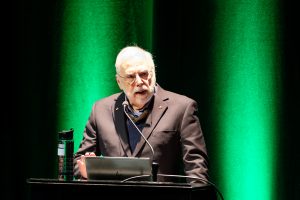News
A Nobel Prize winner in Physics, Donna Strickland, sheds light… on light
Professor Donna Strickland
Photo : Photo : Michel Caron - UdeSOn January 11th, the Institut quantique of Université de Sherbrooke (UdeS) had the honor of hosting the first Canadian to win the Nobel Prize in Physics, Professor Donna Strickland.

Photo : Michel Caron
The story behind the laser’s discovery
As a fundamental element of life on our planet, light has its own UNESCO (United Nations Educational, Scientific and Cultural Organization) international day dedicated to its essential role in science, culture and art, education, and sustainable development, as well as in various fields such as medicine, communications, and energy. As early as the 11th century, Ibn Al-Haytham (Alhazen) devoted research to light and it continues to interest scientists.
Closer to our time, Einstein theoretically demonstrated that it (https://www.aps.org/publications/apsnews/200312/history.cfm) is possible to stimulate light. Townes and Schawlow published for the first time the theoretical basis of the laser (light amplification by stimulated emission of radiation) in Physical Review in 1958 (Infrared and Optical Laser). They each won a Nobel Prize, Townes in 1964 and Schawlow in 1981.
Ultimately, it was in 1960 that the engineer and physicist Theodore Maiman succeeded for the first time in emitting a beam of highly concentrated light thanks to the stimulated emission produced in a ruby crystal. Since then, the laser has been refined to the point of being part of our daily lives at the grocery store or at a concert. Laser technologies are also increasingly applied in the field of eye surgery. In fact, it was to commemorate this day in 1960 that UNESCO established May 16th as the International Day of Light.
Nobel Prize in 2018
As the first Canadian and third woman to ever win the Nobel Prize in Physics, our guest, Professor Donna Strickland of the University of Waterloo, is directly involved in this scientific lineage dedicated to the understanding and use of light.
In fact, the publication that won her the 2018 Nobel Prize in Physics was the result of doctoral work carried out under the direction of Prof. Gérard Mourou at the University of Rochester in 1985, who also won the Nobel Prize. They are the two architects of chirped pulse amplification, a method for creating ultrashort, very high-energy laser pulses.
When trying to amplify an ultrashort pulse in a non-linear system, the laser pulse’s peak power is limited by the damage threshold of the amplifying crystal. The technique developed by Strickland and Mourou in 1985 circumvented this physical limitation, by a smart distribution of the light energy in time. First, the laser pulses are temporally stretched, using classical frequency dispersion technologies. The pulses can then be amplified in the gain medium (without damaging it), and then recompressed at the output of the amplifier crystal via the same mature frequency dispersion technologies.
A lasting impact in UdeS Labs
Several research groups at the Université de Sherbrooke are using laser technologies that take advantage of this “frequency-drift shaped source pulse amplification” technique. In the Faculty of Science and the Faculty of Engineering, these laser technologies are commonly used to produce, by non-linear effect, ultra-short pulses that can cover a wide range of frequencies, from infrared to ultraviolet. Professor André Bandrauk from the Department of Chemistry, is one of the pioneers in the field of molecular photonics used to study the movement of electrons within molecules and to produce attosecond pulses of very high energy. Denis Morris, a professor in the Department of Physics and a member of the Institut Quantique, explains that Prof. Strickland’s work has had a major influence on the field and on the development of compact (or “table-top”) laser systems.
“I widely use these laser systems to perform my pump-probe experiments to study the optical and electronic properties of advanced materials, as well as to study ultrafast phenomena in solids (hot carrier energy relaxation in nanostructures, spin-charge conversion, electron-phonon coupling, etc.).”
Paul-Ludovic Karsenti, coordinator of the photonics laboratories in the Department of Chemistry, uses a derivative of Dr. Strickland’s work. “Two weeks after starting my master’s degree at the Université de Montréal, my research director Carlos Silva asked me to prepare a short presentation on chirped pulse amplification. The idea was to make us understand not only how to obtain the intense femtosecond pulses we were using, but also to appreciate how elegantly it was possible to manipulate laser pulses spectrally and temporally. I have been using amplified femtosecond lasers almost daily for more than 15 years to set up various experimental setups to probe ultrafast electronic dynamics in all types of materials.
The method presented by Prof. Strickland, based on an improved understanding of the interactions between matter and laser, has led to a quantum leap in laser technology. The technical advances used for corneal laser surgery, or the micromachining of glass used in cell phones are just a few examples of research on light and its lasting impact on our daily lives.

